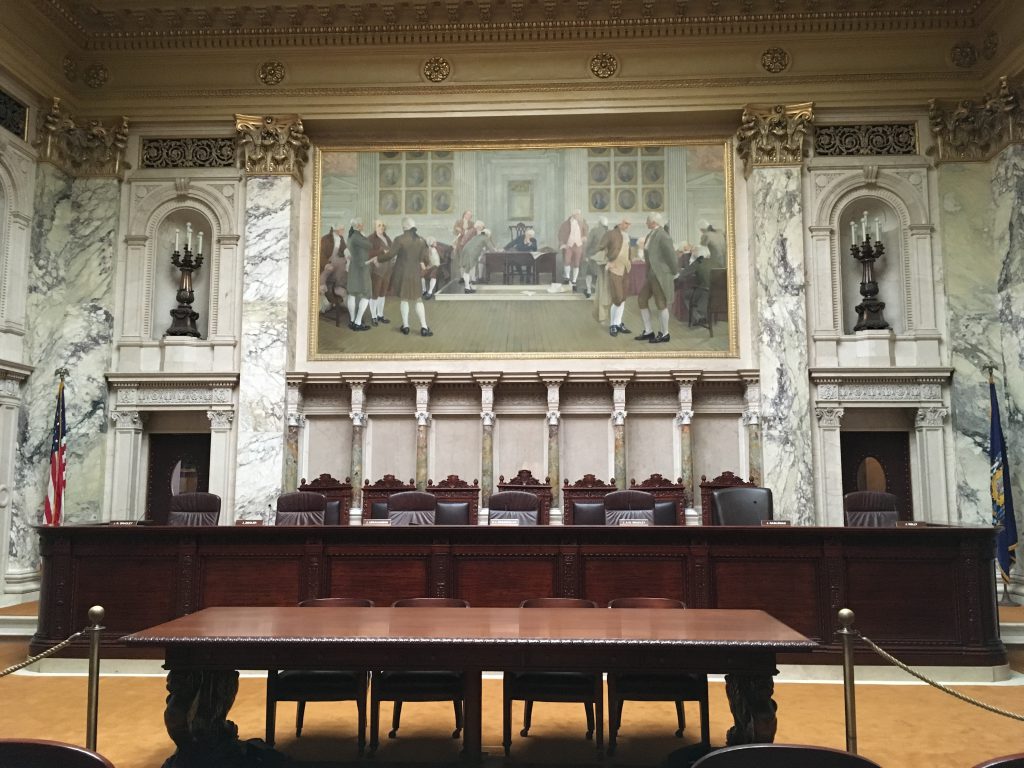Justices Favoring New Legislative Maps Face Tough Questions
Must entire state be redistricted? And who should court ask to draw the maps?
The four-justice state Supreme Court majority that seems intent on ordering some new legislative district maps must answer some very complex logistical and political questions in whatever ruling it issues.
In three hours of lively debate last week, conservative justices repeatedly stressed that the district lines the court ordered in April 2022 is a legal precedent that should not be overturned until new lines are drawn after the 2030 census. “Everybody knows why we’re here,” said conservative Justice Rebecca Bradley, challenging lawyers for Democratic legislators and other groups who want new maps drawn before November 2024 elections
Bradley referred to the April election of Justice Janet Protasiewicz, who replaced retiring conservative Justice Pat Roggensack who was one of four justices that put in place the current boundaries that Democrats insist unfairly favor Republicans who have controlled the Legislature for 12 years.
The April 2022 ruling putting current lines in place was “conclusive,” Bradley insisted, asking lawyers for the Democrats why they “sat on their hands” and didn’t file the new challenge until Protasiewicz joined the Court in August.
But that reconsideration question was decided in October, when the new four-justice majority ordered that current legislative district lines be reviewed and Protasiewicz refused requests to recuse herself from the rehearing. That shifted the debate to important questions the four-justice majority will have to decide:
First, how badly do the current lines for the 99 Assembly districts, which are the building blocks for the 33 Senate districts, fail constitutional requirements that districts be “contiguous” and compact and respect town boundaries as much as possible? Should new maps be redrawn statewide, or only regionally?
The number of “islands” of voters whose homes are not physically connected to the Assembly district they are assigned to is unconstitutional and “shocks people,” argued Mark Gaber, one of several attorneys asking for new maps.
“Over half the Assembly districts in this state have a [contiguity] problem,” said Justice Jill Karofsky. “If we find these maps unconstitutional, don’t we just start all over?”
But “minor adjustments” in only three only regions — Oshkosh, Madison and Eau Claire — would move about 15,000 voters into new Assembly districts and fix most of those problems, countered Rick Esenberg of the Wisconsin Institute for Law and Liberty.
“You can fix this problem,” Esenberg added. “You exist to solve legal problems, and not to redistrict anew.”
Second, if both Assembly and Senate boundaries the court approved last year are unconstitutional, should special elections be held in November 2024 for the 17 senators who won four-year terms last November? That would mean that all 132 legislators – 99 Assembly members and 33 senators – would be up for election in November 2024.
“Unseating the 17 senators who won four-year terms last year would be an “extraordinary remedy,” Bradley said. “I can’t imagine something less democratic.”
Protasiewicz seemed to agree, calling forcing those 17 senators to run again an “extreme” option.
Third, who should draw new maps, since justices made it clear they do not have the technical expertise to do so? Justice Rebecca Dallet asked that question of every lawyer who appeared before the court, saying she wanted to make sure no special-interest group “put a thumb on the scale.”
Some lawyers offered the names of national experts in Alabama or California, or suggested that the Legislative Technology Services Bureau, which supports the Legislature, would have the expertise to implement any court order.
Justice Brian Hagedorn called court-drawn legislative districts a “slippery slope.” Every special-interest group involved offers maps favoring their partisan political interests, Hagedorn warned.
Fourth, would court-drawn maps violate the constitutional requirement that power be shared equally between the executive branch of government headed by the governor, the legislative branch and the judicial branch?
Because the state Constitution requires that new district lines be redrawn every 10 years by legislators and the governor, “You must give the Legislature a chance to redistrict,” said Taylor Meehan, representing Republican legislators.
Chief Justice Annette Ziegler, a conservative who also signed the order putting the current lines in place, was frustrated by the speed at which the new four-justice majority forced the full court to revisit whether those boundaries are constitutional. Ziegler noted that the court had no record of testimony and evidence from lower courts to consider.
“We don’t have facts before us,” Ziegler said. “Why start it here, and why start it now? This was fast-tracked to the end game.”
Steven Walters started covering the Capitol in 1988. Contact him at stevenscotwalters@gmail.com
If you think stories like this are important, become a member of Urban Milwaukee and help support real, independent journalism. Plus you get some cool added benefits.
More about the Gerrymandering of Legislative Districts
- Without Gerrymander, Democrats Flip 14 Legislative Seats - Jack Kelly, Hallie Claflin and Matthew DeFour - Nov 8th, 2024
- Op Ed: Democrats Optimistic About New Voting Maps - Ruth Conniff - Feb 27th, 2024
- The State of Politics: Parties Seek New Candidates in New Districts - Steven Walters - Feb 26th, 2024
- Rep. Myers Issues Statement Regarding Fair Legislative Maps - State Rep. LaKeshia Myers - Feb 19th, 2024
- Statement on Legislative Maps Being Signed into Law - Wisconsin Assembly Speaker Robin Vos - Feb 19th, 2024
- Pocan Reacts to Newly Signed Wisconsin Legislative Maps - U.S. Rep. Mark Pocan - Feb 19th, 2024
- Evers Signs Legislative Maps Into Law, Ending Court Fight - Rich Kremer - Feb 19th, 2024
- Senator Hesselbein Statement: After More than a Decade of Political Gerrymanders, Fair Maps are Signed into Law in Wisconsin - State Senate Democratic Leader Dianne Hesselbein - Feb 19th, 2024
- Wisconsin Democrats on Enactment of New Legislative Maps - Democratic Party of Wisconsin - Feb 19th, 2024
- Governor Evers Signs New Legislative Maps to Replace Unconstitutional GOP Maps - A Better Wisconsin Together - Feb 19th, 2024
Read more about Gerrymandering of Legislative Districts here
The State of Politics
-
A Wisconsin Political Trivia Quiz
 Dec 15th, 2025 by Steven Walters
Dec 15th, 2025 by Steven Walters
-
The Fight Over Wisconsin’s House Districts
 Dec 8th, 2025 by Steven Walters
Dec 8th, 2025 by Steven Walters
-
The Battle Over On-Line Betting
 Nov 24th, 2025 by Steven Walters
Nov 24th, 2025 by Steven Walters




















The 4 questioned raised in this opinion piece as well as the objections of the conservative justices ARE exactly why the maps must be redrawn at this time. There is no such “constitutional” principle of least change, which was the cornerstone of the April 22 decision. Vos and company HAVE had their thumbs on the scale through 2 redistricting cycles. As for democratic elections, how many of those 17 senators who would have to face new elections actually ran unopposed? Setting up district maps in which senators and legislators chose their constituents is the height of undemocratic elections. As for sharing power, the Republicans have made it very clear they don’t want to share power with either the executive or judicial branches. They don’t want to share power with their constituents. Another reason the April 22 decision was such a travesty.
Finally, why is it the conservative members of the court had no problem “fast-tracking” cases from the Republican controlled legislature BUT do have a problem when it comes from democrats whose voices have been silenced by unconstitutionally gerrymandered districts? The partisan court majority behind the April 22, 2022 decision failed in their service to the people of Wisconsin. Their failure is why a new court, better reflecting the will of Wisconsin voters, must rectify the situation.